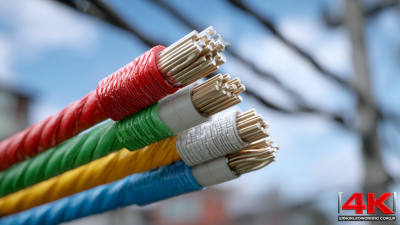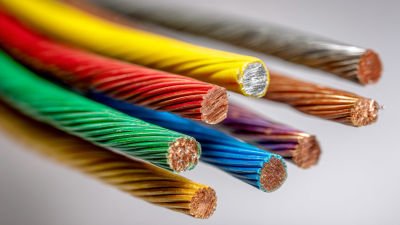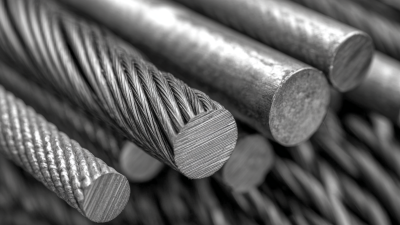Understanding the Importance of High Temperature Cable in Industrial Applications and Its Role in Future Technologies
In today's industrial landscape, the significance of High Temperature Cable cannot be overstated, especially as industries seek to enhance efficiency and durability in extreme environments. According to a recent report by Smithers Pira, the global market for high-performance cables is projected to grow at a CAGR of 5.6%, reaching $30 billion by 2025. This growth is largely attributed to the increasing demand for reliable cabling solutions in industries such as aerospace, automotive, and oil and gas, where exposure to high temperatures can significantly impact equipment performance. As manufacturers turn their attention to innovative technologies, High Temperature Cable stands out as a critical component, offering enhanced thermal stability and resistance to environmental stressors.

By understanding the essential role of these specialized cables, companies can better prepare for the future, ensuring their operations remain robust and efficient in an ever-evolving industrial landscape.
The Significance of High Temperature Cables in Modern Industrial Processes
High temperature cables play a crucial role in modern industrial processes, especially in the context of advancing renewable energy technologies. As industries shift towards sustainable practices, the demand for reliable materials that can withstand extreme temperatures is increasing. According to industry reports, the high temperature wire and cable market is projected to grow significantly, driven by applications in sectors such as solar and wind energy, where operational longevity and efficiency are paramount.
Tips: When selecting high temperature cables for your projects, ensure that they meet the specific temperature ratings required for your application. This not only enhances reliability but also contributes to energy efficiency and cost savings over time.
Moreover, as the transition to renewable sources accelerates, optimizing energy utilization has become imperative. Industries are seeking solutions that minimize energy losses and reduce carbon footprints. High temperature cables facilitate this by maintaining performance in high-stress environments, which is essential for maximizing energy output from renewable installations. Reports suggest that effectively managing heat within these systems can lead to a substantial reduction in operational costs and environmental impact.
Tips: Consider the thermal management properties of cable materials when designing systems for high-energy applications. Investing in high quality, temperature-rated cables can yield long-term benefits in both performance and sustainability.
Essential Features of High Temperature Cables for Extreme Environments
High temperature cables are critical components in industrial applications, particularly in environments exposed to extreme conditions. These specialized cables are designed to maintain integrity and performance where conventional cables might fail. According to a report by MarketsandMarkets, the global high-temperature wire and cable market is projected to reach $6.4 billion by 2025, highlighting the growing demand for reliable electrical conductivity in harsh environments.
One of the essential features of high temperature cables is their ability to withstand temperatures up to 200°C or even higher, depending on the insulation material used. These cables are typically constructed with materials such as silicone, Teflon, or mica, which allow them to resist not only high thermal stress but also chemicals and mechanical wear. Additionally, these cables possess excellent dielectric properties, ensuring minimal signal loss and maintaining safety standards in demanding industrial settings. Industry data suggests that utilizing high temperature cables can reduce maintenance costs and increase operational efficiency, reinforcing their importance in the trajectory of future technologies.
Understanding the Importance of High Temperature Cable in Industrial Applications and Its Role in Future Technologies - Essential Features of High Temperature Cables for Extreme Environments
| Feature | Description | Applications | Temperature Range |
|---|---|---|---|
| Heat Resistance | Able to operate in high-temperature environments without degradation. | Power plants, steel manufacturing. | Up to 300°C |
| Flexibility | Designed for flexibility even at high temperatures. | Robotics, automated machinery. | -40°C to 200°C |
| Chemical Resistance | Resistant to various industrial chemicals and substances. | Chemical processing, oil refineries. | Up to 250°C |
| Durability | Long-lasting performance in extreme environments. | Mining, heavy machinery. | -55°C to 150°C |
| Electrical Performance | High conductivity and low resistive losses. | Electronics, electrical distribution. | -60°C to 230°C |
Exploring the Role of High Temperature Cables in Renewable Energy Technologies
High temperature cables are becoming essential in numerous industrial applications, especially within the renewable energy sector. These cables are designed to withstand extreme thermal conditions, making them suitable for environments where conventional cables would fail. The global electrical insulation paper market, which encompasses materials like Tufquin, Nomex, and mica-based papers, is estimated to grow significantly due to the increasing demand for high-performance insulation in power cables and other critical applications. According to recent industry analyses, the demand for high temperature cables is projected to expand robustly, driven by advancements in renewable energy technologies.
In the renewable energy landscape, high temperature cables play a crucial role by ensuring efficiency and safety in the transmission of power generated from sources such as solar and wind. With a growing emphasis on reducing carbon footprints, industries are increasingly opting for materials that can sustain high operating temperatures while ensuring durability and performance. Reports suggest that the market share for electrical insulation papers used specifically in high temperature applications is expected to rise, reflecting the industry's shift towards sustainable practices. The regional insights highlight a notable increase in demand across North America and Europe, where renewable energy initiatives are gaining momentum, further driving the need for reliable high temperature cable solutions.
Future Innovations: Advancements in High Temperature Cable Design and Materials
As industries pivot towards renewable energy and sustainability, high temperature cables are poised to play a crucial role in the advancements this sector demands. Recent reports indicate that the global market for high temperature superconducting (HTS) materials is projected to reach over $1.6 billion by 2027, driven by the expanding use of such technologies in applications like wind and solar energy systems. These cables can operate at elevated temperatures where traditional materials fail, enhancing the efficiency and reliability of power transmission while reducing energy losses.
Innovations in cable design and materials are essential for supporting the growing demands of smart infrastructures and renewable energy grids. High temperature cables are not only integral to the energy transition but also facilitate the integration of emerging technologies such as fusion energy. Recent studies suggest that advanced materials are pivotal in accelerating commercial fusion projects. By enabling higher performance and more durable components, these innovations are critical in the race toward cleaner, more efficient energy solutions that align with modern sustainability goals.
Comparative Analysis: High Temperature Cables vs. Standard Cables in Industry
High temperature cables, often referred to as switchgear cables or control panel wires, play a crucial role in industrial applications due to their ability to withstand extreme thermal conditions. These cables, which include features like flamability resistance and enhanced flexibility, are primarily utilized in electrical cabinets, rectifier equipment, motor starters, and various switching control devices. In contrast to standard cables, high temperature cables are designed to operate effectively in environments that experience frequent temperature fluctuations, ensuring reliable power supply to critical components such as relays and instrumentation panels.
The rising demand for high temperature superconducting cables reflects advancements in technology and sector growth driven by national policies. High temperature superconducting materials exhibit superconducting properties at relatively higher temperatures compared to traditional superconductors, allowing for significant reductions in transmission losses. As the industry transitions towards greener technologies, the competitive landscape has shifted, with numerous innovative enterprises emerging in the market. According to a 2021 industry report, leading companies in China's superconducting sector include several representatives gaining recognition for their contributions to high temperature superconducting cable commercialization. This trend suggests a robust future for high temperature cables, particularly as the push for energy-efficient solutions continues to gather momentum.
Related Posts
-

15 Best Practices for Selecting High Temperature Wire for Your Applications
-

Empowering the World with China's Leading Electrical Power Cable Innovations
-

Maximizing Value with Best Top Cable Solar After Sale Service and Maintenance Cost Advantages
-

Ultimate Comparison: Top 5 Best Medium Voltage Cables for Your Industrial Needs
-

Navigating Industry Production Standards Challenges for Best Medium Voltage Cable
-

Top Strategies for Sourcing High-Quality Solar Electric Solutions Globally
